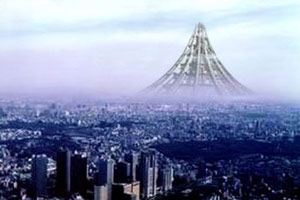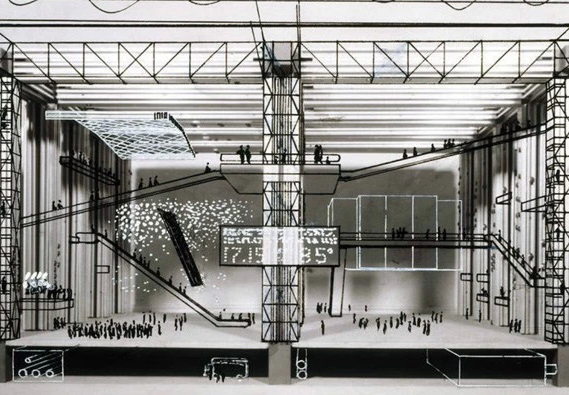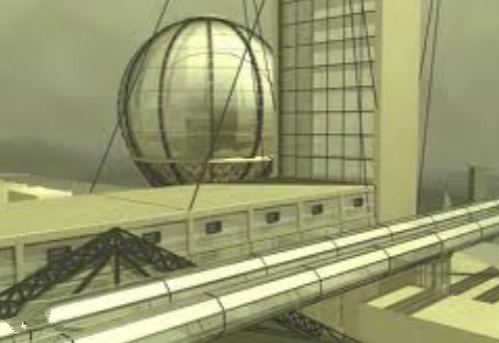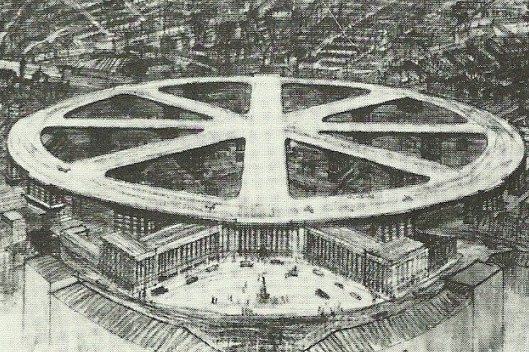(单词翻译:单击)
Human history is littered with incredible monuments we stupidly tore down. But plenty didn't even make it that far. Go digging through dusty old ledgers and architects' scrapbooks, and you'll uncover a wealth of awe-inspiring structures ripped straight out a retro sci-fi film—structures that really never could have worked.
人类历史上充斥着被我们稀里糊涂拆毁的惊人建筑遗迹。但还有很多甚至没有成型。翻阅布满灰尘的旧账簿和建筑师的手稿本时,你会看到大量曾出现在复古科幻电影里的结构设计图,这些建筑设计令人惊叹,可它们并未成为现实。
10.The Tokyo Tower Of Babel
10.东京通天塔

Imagine the entire height of Mount Everest, all 8,848 meters (29,029 ft). Now imagine some lunatic had built Dubai's record-breaking Burj Khalifa on top of it. Congratulations: That tower plus the mountain (10 times taller) below it combined still fall a couple of hundred meters short of the Tokyo Tower of Babel.
想象在你面前的是一座高达8848米(29, 029英尺)的珠穆朗玛峰。然后一个疯子在峰顶建造了迪拜那座破纪录的哈利法塔。恭喜!这大概就是东京通天塔的高度,比哈利法塔和高于塔十倍的珠穆朗玛峰的高度之和再高几百米。
The craziest building Japan never built was dreamed up in the dying days of the bubble economy in 1991. Clocking in at a cool 10,000 meters (around 6.2 miles), it would have taken up to 150 years to build, cost $306 trillion and housed 30 million people. It would also been bigger than many countries. When a comparatively tiny 4,000-meter (13,000 ft) tower was proposed around the same time, somebody crunched the numbers for one the same size as Everest. They concluded that a tower that large would need a base of 4,100 square kilometers (1,500 mi2)—an area of ground nearly twice the size of Luxembourg. The base for Tokyo's Babel would have been even larger. Although it was proposed during a Japanese craze for structures bigger than mountains, it's not clear Babel was ever intended to be built. And by the time the architects made the proposal, the economy was well and truly crashed.
这座疯狂的、从未实现的日本建筑构思在1991年泡沫经济末期成型。建造一座10,000米的通天塔需要花费150年的时间、306万亿美元和3000万的劳动力。这座塔的面积甚至比许多国家还要大。差不多在同一时期,当提出修建一个相对小点、大概4000米(13,000英尺)高的塔时,有人计算出如珠穆朗玛峰一般大小的建筑物的相关数据。他们推断,修建一座面积这么大的的塔需要一个4,100平方千米(1,500平方英里)的地基,这个地基的面积差不多是卢森堡的两倍。那么,东京通天塔的地基将更大。虽然提出通天塔的构思时,日本人正疯狂地迷恋比山脉还要高大的建筑物,但人们是否真的打算修建这么一座塔就不得而知了。而且,当建筑师提出修建通天塔的时候,日本经济已经全面崩溃。
9.The Fun Palace
9.游乐宫

By the late 1950s, Joan Littlewood had already ensured her place in the history books. A British theater director, she was known for smashing down boundaries to make plays more accessible. But rewriting the theater rulebook wasn't enough. Littlewood wanted to change the way we saw theaters themselves.
二十世纪五十年代末,琼·利特伍德就已确立了她的历史地位。她是一名英国戏剧导演,因打破局限使戏剧更通俗易懂而出名。但她不满足于对戏剧规则的创新。利特伍德想进一步改变观众观赏戏剧的方式。
In 1960, Littlewood hired architect Cedric Price to design the most radical theater in history. His Fun Palace, as it became known, redefined what architecture could do. Taking inspiration from cybernetics theories, avant garde playwrights, and Monty Python, he drew up plans for a building where nothing stayed in one place. Everything from the seats inside, to the stages, to the lobby, to the cafe and cinema screens could be shunted around and reconfigured at will. Where the stage was one day, you might have the box office the next. Where the changing rooms had been on Monday, you could have the auditorium by Tuesday. No two visits would ever be the same. If that sounds potentially confusing, you're not alone. People hated it. Church groups, local citizens, and London's councils all conspired to stop the Fun Palace going ahead. When permission finally came through in the 1970s, funding mysteriously dried up. Work never even started.
1960年,利特伍德雇请建筑师塞德里克·普莱斯设计了一座史上最与众不同的剧院。他的构想后来被人们称为游乐宫,改变了人们对建筑学的看法。塞德里克从控制理论、前卫剧作家还有蒙提·派森巨蟒剧团那里汲取灵感,想要设计一座所有东西都可变换位置的建筑。建筑里的座椅、舞台、大厅、咖啡馆、电影屏幕都可以随意转移重组。今天是舞台的地方明天可能会变成售票区。某个地方星期一还是更衣室,很可能星期二就成了观众席。每次去都会发现剧院有所变化。你绝不是唯一一个认为这玩意儿很混乱的人。很多人都不喜欢这个设计。宗教团体、当地居民以及伦敦委员会协力阻止游乐宫的修建。到二十世纪七十年代,这座建筑终于获准施工,资金却神秘消失了。因此游乐宫从未动工。
8.The Cenotaph For Newton
8.牛顿纪念碑

Etienne-Louis Boullee was fascinated with Isaac Newton. A neo-classical architect working in 18th-century France, he thought the groundbreaking mathematician deserved an equally groundbreaking monument. So he sat down and drew up designs for the biggest, craziest sphere on Earth.
艾蒂安·路易·布雷对艾萨克·牛顿十分感兴趣。作为一名18世纪在法国工作的新古典主义建筑师,布雷认为这位富有突破性的数学家理应得到一个同样极富开创性的纪念碑来纪念他所取得的成就。于是他坐下来起草设计了地球上最大、最疯狂的球体。
A 1,500-meter (500 ft) orb encased in a sheer cylindrical base, the cenotaph would have dwarfed the Great Pyramid at Giza. It would also have invoked a sensation of vertigo in anyone foolish enough to visit. After climbing up a gigantic staircase, visitors would crawl through a tiny tunnel into the inside of the orb. There, they would encounter a vast, sightless void stretching on seemingly forever. At the very center of this disconcerting blank would sit a single sarcophagus containing the body of Newton, a speck against the emptiness of the universe. Tiny holes in the skin of the sphere would have let pinpricks of light through in the shape of the constellations. There were even plans to somehow create a fog effect inside the sphere, giving everything a weird, haunted air. For reasons of practicality, the thing sadly never got built.
这个球体直径为1,500米(500英尺),被一个陡峭的圆柱形基座包围,这样一个纪念碑会让吉萨大金字塔都相形见绌。这个纪念碑会使任何傻到前来参观的人产生眩晕感。爬上一个巨大的楼梯之后,参观者们将匍匐穿过一条极细的通道进入球体内部。在那里,他们会看到一个巨大的、无限蔓延的空间。在这个令人困惑的空间的正中央,是一个安放着牛顿遗体的石棺,作为对抗宇宙空虚的一点。球体表面的小孔会使星光照射进来,呈现出星座的形状。布雷甚至还计划在球体内部制造烟雾效果,让一切沉浸在怪异可怖的气氛中。但遗憾的是,出于实际考虑,这个纪念碑永远不可能付诸实施。
7.Ivan Leonidov's Lenin Institute
7.伊万·列奥尼多夫的列宁研究所

In 1927, Ivan Leonidov was an architecture student with everything to prove. A radical Russian of the constructivist school, Leonidov wanted to make the biggest splash possible with his graduate designs. He wound up aiming far too high. His proposal for the Lenin Institute in Moscow was both breathtakingly ornate and completely unbuildable.
1927年,伊万·列奥尼多夫还是一个不曾显露才华的建筑系学生。作为一名构建主义学校的激进的俄国学生,列奥尼多夫想让自己的毕业作品大放异彩。由于最终目标过高,他对莫斯科列宁研究所的提议惊人的华美却又全无建造的可能。
Designed to function as a combined library and lecture hall, everything about Leonidov's plans screamed "big." The library alone would have held 15 million books, along with five reading rooms each capable of housing 500–1,000 visitors. Such a huge library needed a similarly huge delivery system, so Leonidov stuffed it full of clanking conveyor belts that whisked books skyward dozens of stories at a time. He also included a gigantic sphere for lectures. Capable of seating 4,000, the enormous glass orb could fold open in half and housed its own private tram system running direct to Moscow. To top it all off, Leonidov then included a radio station.Although the design won Leonidov plenty of admirers, architect Moisei Ginzburg perhaps summed it up best when he remarked Leonidov "was not really able to prove that his constructive conundrum was actually necessary" and called it "impossible."
由于意在使研究所兼具图书馆和讲堂的功能,在列奥尼多夫的设计中,一切都"大"得惊人。仅图书馆就能够收藏一千五百万本图书,还有五间阅览室分别可以容纳五百到一千位读者。这样一个巨大的图书馆需要一个同样工程浩大的运送系统,于是列奥尼多夫在图书馆内装满了叮当作响的传送带以便能一次把书运到几十层楼之上。他还计划将讲堂建造成一个巨大的球体建筑。这个巨型玻璃球可以容纳四千个座位,能够对折打开,内置独有的有轨电车系统可以直达莫斯科。更不得了的是,列奥尼多夫还计划建造一个无线电台。尽管这个设计为列奥尼多夫赢得了诸多赞誉,但建筑师莫伊谢伊·金兹伯格对列奥尼多夫的评价总结得最为精辟——"(他)不能证明他提出的建筑难题真的有必要",并称这个设计是"不可能的"。
6.London's Safety-Defying Airports
6.无视安全的伦敦飞机场

If you've ever been to London, you'll know inserting an airport into the city center is a madman's dream. Meet that madman: Charles W. Glover. In 1931, Glover produced designs for bringing air travel to central London. He did it by throwing every safety regulation out the nearest window.
如果你去过伦敦,那你应该知道,在伦敦市中心建机场简直是个疯狂的想法。让我们见识下提出这个想法的人:查尔斯·W·格洛费。1931年,格洛费提出在伦敦市中心建机场的设想。他的这一设计将所有的安全章程抛在了脑后。
Glover proposed a £5 million wheel-shaped runway that would sit on top of thousands of homes. Stretching from Kings Cross to Trafalgar Square, it had private garages for personal airplanes, lifts to bring people up from ground level, and absolutely nothing to stop an incompetent pilot from careening off the end and right into the heart of London's shopping districts. Although the potential for catastrophe was clearly enormous, people still took Glover seriously. A watered-down version of the project was still being considered as late as the 1960s.Glover wasn't the only one to take a cavalier approach to Londoners' safety. A 1930s proposal suggested placing an airport next to Westminster, where a bad crash could easily wipe out the government. Another from the 1950s aimed to place a landing platform for personal helicopters directly above Charing Cross Station. As Popular Science blithely noted, this new landing pad would helpfully include "radar aids for landings in London's pea-soup fogs."
格洛费计划花500万英镑在上千所房子上空修建轮形跑道。轮形跑道从英皇十字区延伸到特拉法尔加广场,为私人飞机建设了停机场,提供电梯方便人们升降,并且绝不会有任何东西妨碍不够格的飞行员将飞机歪歪斜斜地开出跑道,然后冲进伦敦商业区的中心地带。显然这项设计的潜在风险很大,但人们还是认真考虑了格洛费的这一设想。直到20世纪60年代,人们还在考虑采取一个更缓和的计划。格洛费不是唯一一个对伦敦居民的安全漫不经心的人。20世纪30年代,有人提议在威斯敏斯特旁建一个机场,在那里发生一次严重的飞机事故就能轻易摧毁政府。在20世纪50年代,还有人提出了另一个建议,要在查林十字车站的正上方为私人直升飞机建一个停机坪。《科技新时代》指出,这个新的停机坪大有用处,"有雷达辅助设备,能帮助飞机在伦敦的浓雾天里着陆"。
审校:赵倩 来源:前十网


